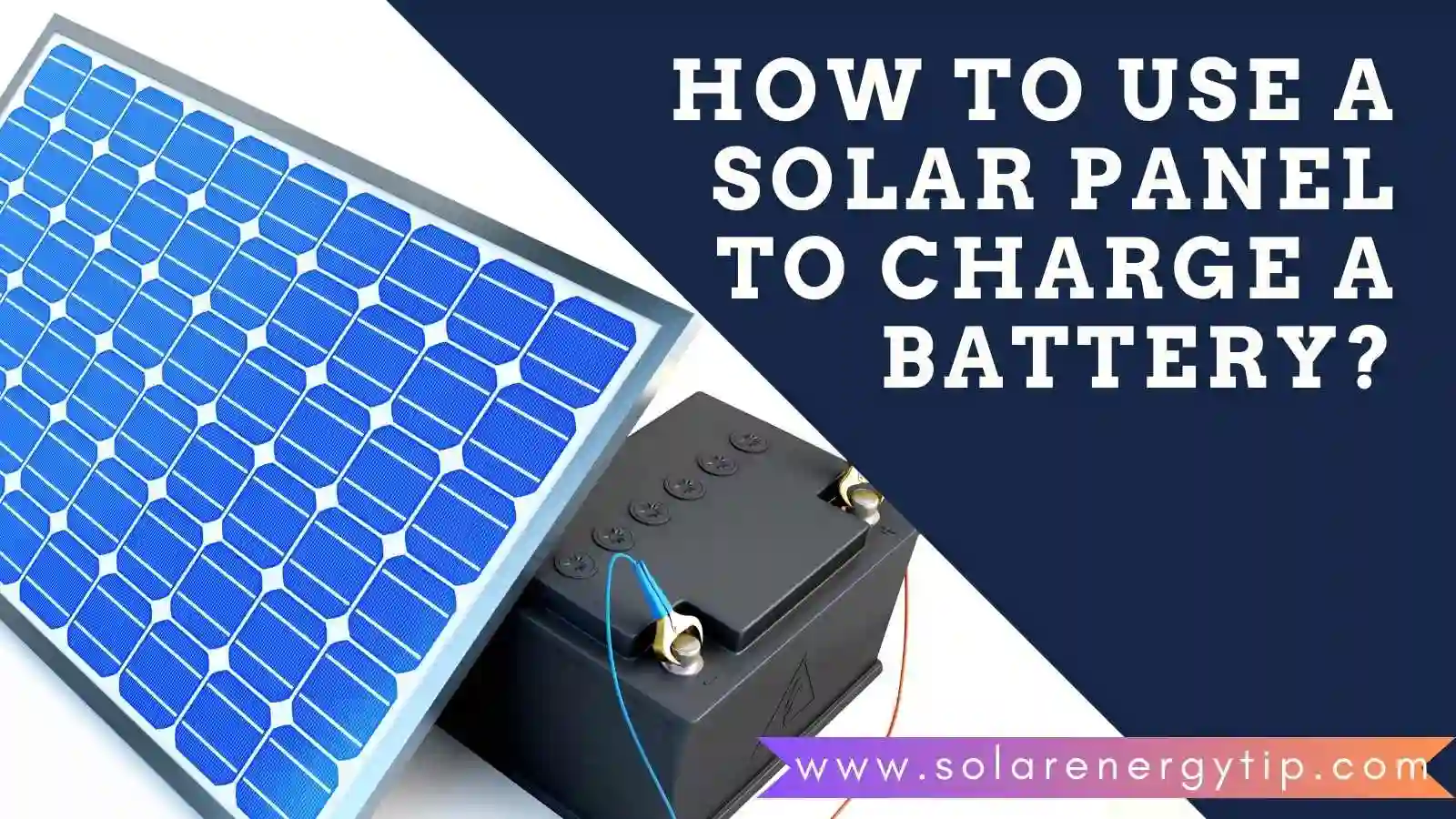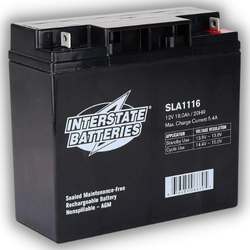If you are using an inverter in your home, then the question of how to use a solar panel to charge a battery will be in your mind. How to charge a different type of battery for a solar panel?
Did you know that solar energy is a clean and renewable energy? Using it to charge your home battery is cheap and good for the environment.
With the help of a solar panel, you will not incur any cost if you charge the battery. Once it is your investment, you can get as much energy as you like.
And if anyone is installing solar panels in their house, they need to know how to get electrical energy and use a solar panel to charge a battery.
That’s great 🙂
Because you read my article, you want to use clean and renewable energy to live solar energy because this is an excellent energy source, so we should use it.
- What Equipment Do You Need to Charge a Battery with a Solar Panel?
- How To Use A Solar Panel To Charge A Battery? Brief information
- How to Set Up a Solar Panel to Charge a Battery? 9 Steps Guide 🔋
- Explain the Wiring Connection With the Charge Controller
- Charging a Battery With a Solar Panel Circuit
- How Do Solar Panels Work to Charge a Battery?
- What are the best Practices for Charging a Battery with a Solar Panel?
- Are There any Limitations or Considerations when Using Solar Panels for Battery Charging?
- Types of Solar Battery
- How to Use a Solar Panel Charges a Battery – Which Uses in Different work
- FAQs
- Conclusion
What Equipment Do You Need to Charge a Battery with a Solar Panel?
To understand this topic & how solar energy works to produce electricity, we are going to get information about some of the equipment;
- Solar Panels
- Solar Charge Controller
- Power Inverter
- Battery Bank
- Battery Monitoring System
- Wiring
- Cutoff Switches
- Fuses
| No | Equipment | Purchase |
|---|---|---|
| 1 | Solar Panels | Check Here |
| 3 | Wires | Check Here |
| 4 | Solar Inverter | Check Here |
| 5 | Solar Charge Controller | Check Here |
| 6 | Solar Rack | Check Here |
| 7 | AC Breaker | Check Here |
| 8 | AC disconnect and fuse | Check Here |
| 9 | 12 Volts Battery | Check Here |
How To Use A Solar Panel To Charge A Battery? Brief information
To charge a battery with a solar panel, connect it to the battery using a suitable wire, ensure it is in direct sunlight, monitor the charging process, and disconnect it when fully charged.
Many people around the world are using renewable energy sources. If you are using solar panels to generate electricity, you must get information about how to set up a solar panel to charge a battery.
You can use this type of solar panel kit to charge a battery. 👇
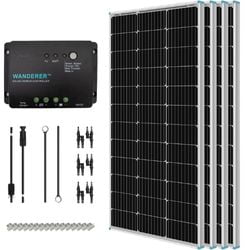
Solar Panel Starter Kit
- 4 pcs 100W Monocrystalline Solar Panel
- 30A Wanderer PWM Charge Controller
- Use in RV, Trailer, Camper, Marine, and Off-Grid Solar Power Systems
How to Set Up a Solar Panel to Charge a Battery? 9 Steps Guide 🔋
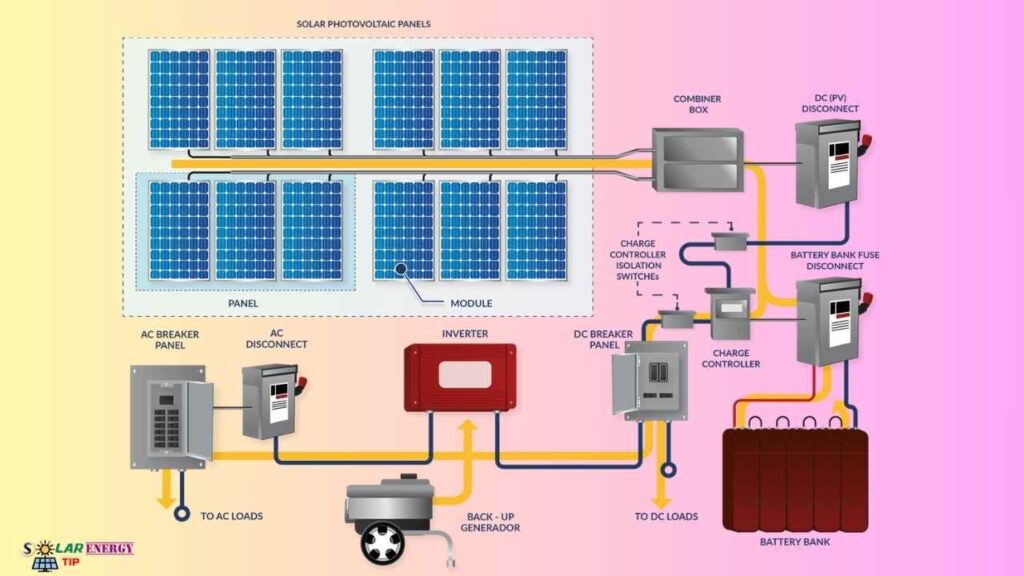
I want to discuss with you the 9 steps I have in mind for using a solar panel to charge a battery.
- Step 1: Choose a solar panel with enough wattage to charge your battery. For a standard 12V battery, select a 50W – 100W solar panel.
- Step 2: Obtain a solar charge controller. This is essential for regulating the power from the solar panel to the battery. It prevents overcharging and damage to the battery.
- Step 3: Get a DC-to-AC power inverter if you need to power AC devices. The inverter converts the DC output of the solar panel/battery to 120V AC power.
- Step 4: Connect the solar panel leads to the charge controller terminals. Match positive (+) to positive (+) and negative (-) to negative (-). Consult the charge controller manual for wiring details.
- Step 5: Use short cables to connect the battery 🔋 terminals to the charge controller. Remember to match the polarity – positive battery cable to the positive terminal, negative to negative.
- Step 6: If using an inverter, connect the inverter output to an AC distribution panel, fuse box, or outlets you want to power.
- Step 7: Ensure the solar panel is positioned where it will receive full, direct sunlight during the day. The system will automatically charge the battery during daylight hours.
- Step 8: Check all wiring connections to ensure they are solid, clean, and insulated to prevent shorts. Add fuses as needed for safety.
- Step 9 Perform regular maintenance like checking connections, cleaning the solar panel, and monitoring battery charge levels. Enjoy your renewable solar energy system.
If you want to set up a portable solar recharge battery system, watch this video properly and apply it yourself.
Explain the Wiring Connection With the Charge Controller
Connection of the Charge Controller to the Battery
Connecting positive and negative wires to your battery. It usually uses red wire for the positive and black for the negative ends.
Of course, if your solar battery already has wires connected, you don’t need to attach new wires to the first battery.
LiTime 30 Amp MPPT Solar Charge Controller
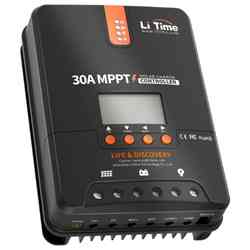
Solar Panel Charge Controller
- 4 pcs 100W Monocrystalline Solar Panel
- 30A Wanderer PWM Charge Controller
- Use in RV, Trailer, Camper, Marine, and Off-Grid Solar Power Systems
Warning: First of all, it is advisable to connect the charge controller to the battery rather than the solar panel
You will see a positive-negative shade attached to the battery, and after connecting it, you will see the other end in the charge controller.
To connect a 12v battery to a charge controller, use a 10 gauge or 16 gauge wire.
Connection of the Solar Panel to the Charge Controller
If you want to connect the charge controller to the solar panel, use MC4 connectors. Usually, the output wires in solar panels have an MC4 connector, which has male and female two sides.
You should take extra care if you are working with electrical work with wiring. Take the time to check a second time to see if your positive and negative wires match.
Here are 7 steps that will help you answer the question of how to use a solar panel to charge a battery.
Read this article for more knowledge. What is the advantage of solar energy?
Charging a Battery With a Solar Panel Circuit
You may range the regulation voltage level consistent with the SLA battery voltage; here, a 3A,50V Schottky diode is used for safety from the reverse supply.
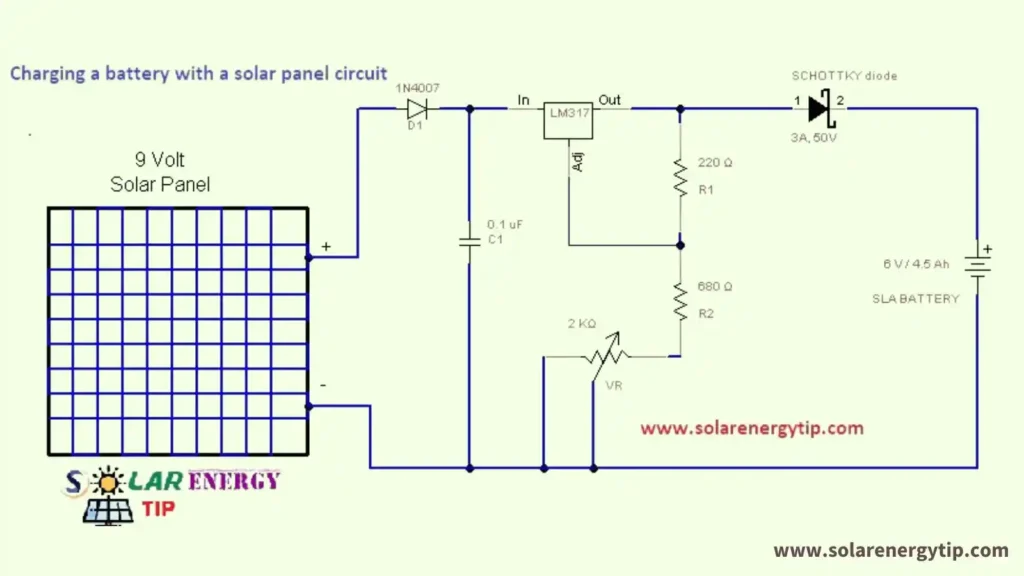
So I have suggested some good tools to charge the battery with a solar panel circuit.
How Do Solar Panels Work to Charge a Battery?
Solar panels generate DC electricity from photovoltaic cells. Sunlight causes the release of electrons from cells, resulting in DC—your electricity.
Solar electricity is transferred to a charge controller, which regulates charging to keep the battery from overcharging or damaging it.
The panels convert sunlight into power, which the battery stores. Very cool procedure. The controller charges your battery safely and efficiently, so it’s always ready.
What are the best Practices for Charging a Battery with a Solar Panel?
Here are some best practices for charging a battery with your solar panel…
- Use a charge controller to regulate charging and prevent overcharging.
- Check voltage and current settings match battery needs.
- Maximize solar exposure – clean panels, optimal angles.
- Use proper wire gauges to minimize losses.
- Monitor battery charge cycles and lifespan.
- Keep connections clean, tight, and corrosion-free.
- Ensure batteries are deep cycle for solar use.
- Avoid cheap, low-quality solar components.
- Size the system correctly – panels and battery.
- Keep batteries away from extreme temps.
Are There any Limitations or Considerations when Using Solar Panels for Battery Charging?
Here are some fundamental limitations and considerations when using solar panels to charge batteries…
- Solar dependent – No sun, no charge policy, so manage usage at night/in bad weather.
- Higher initial cost than grid power. So It’s considered a Longer ROI.
- Solar panel output decreases over time, so plan for replacements.
- Limited power output from panels – size system accordingly.
- Charge controllers and inverters lose some power, which accounts for inefficiency.
- Batteries degrade over time – replace 3-5 years typically.
- Deep cycle batteries are required for solar, not regular car batteries.
- Heat reduces solar panel output and battery life. Ensure ventilation.
Types of Solar Battery
If you want to generate electrical energy through solar panels in your home, you need to know about the solar panel batteries used in it.
Did you know?
There are different types of battery models for storing solar energy. Each of these solar panel batteries has advantages and disadvantages.
There are four main types of solar batteries used in solar systems.
- Lead-acid batteries
- Lithium-ion batteries
- Nickel-based batteries
- Flow batteries
Lead-acid Battery for Solar Storage
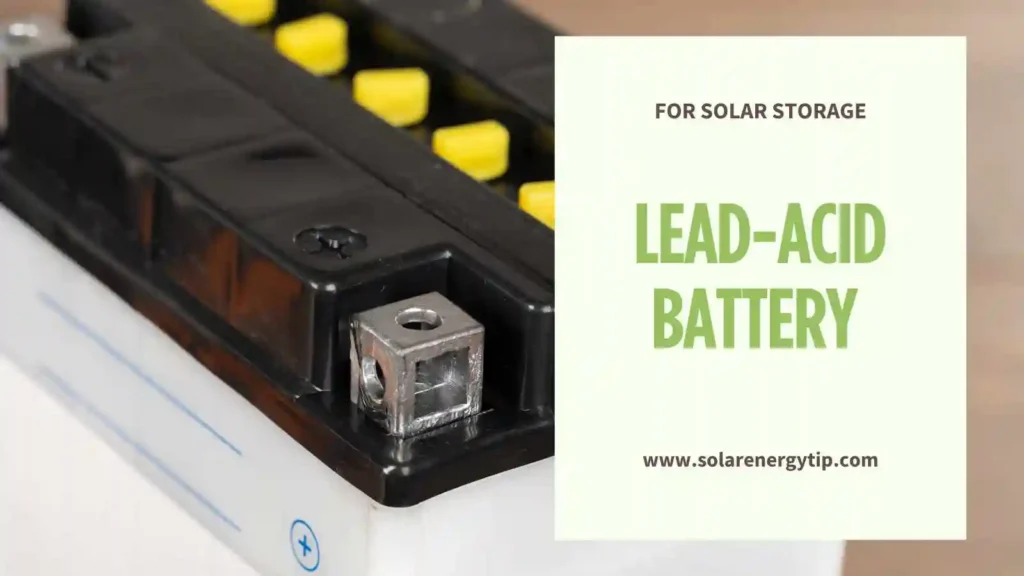
Lead acid batteries are very cheap and range from 382$ to 399$. These lead acid batteries are capable of high specific power and discharge currents.
A lead acid battery is a tested technology you can configure in an off-grid solar power system.
Lead-acid batteries are an excellent example for many homeowners who want to generate electricity with solar panels.
There are also three subtypes of lead acid batteries, which are shown to you as follows:
- Flooded lead acid batteries
- Absorbent Glass Mat (AGM) batteries
- Gel batteries
Lithium-Ion Battery for Solar System
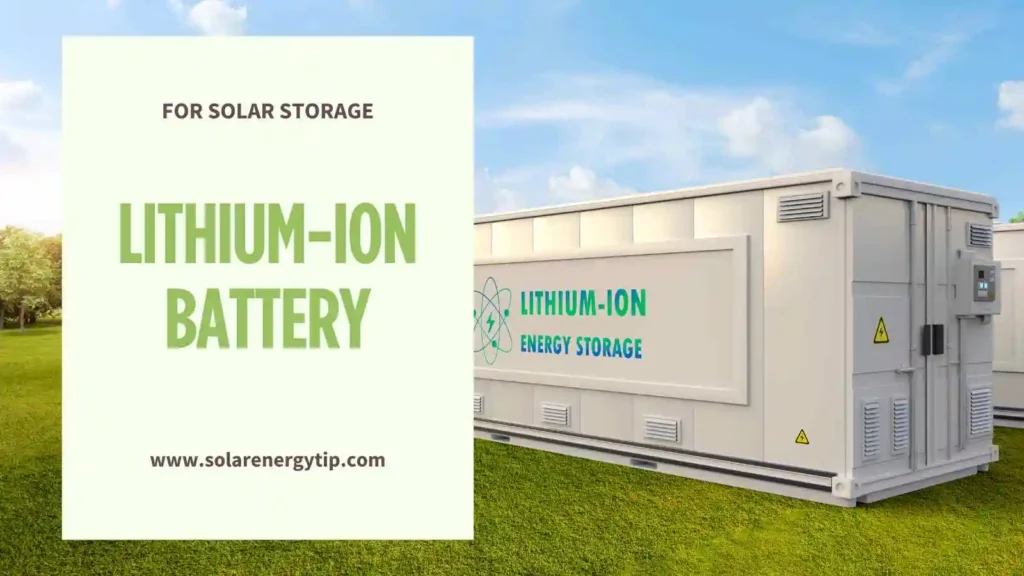
The lithium-ion battery is an excellent example if you want to use the best type of battery to store the electrical energy generated from solar energy in your home.
Lithium-ion batteries have been rated Extreme Fast Charging in the US, according to the US Department of Solar Energy.
Lithium-ion batteries have a longer dod and a longer lifespan when compared to lead acid batteries.
However, lithium-ion batteries are more expensive than lead-acid batteries.
The most famous residential installation uses lithium batteries as follows:
- LiTime 12V 100Ah LiFePO4 Lithium Battery
- Tesla’s Powerwall battery
LiTime 12V 100Ah LiFePO4 Lithium Battery
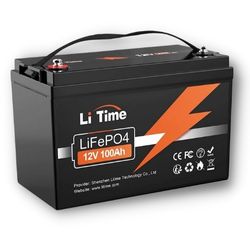
- Lightweight-Easy to Move
- For Trolling Motor
- 95%* Efficiency
- Use in Deep Cycles Backup Power, Perfect for RV, Solar, Marine, and Home Energy Storage
Nickel-Cadmium Rechargeable Battery for Solar System
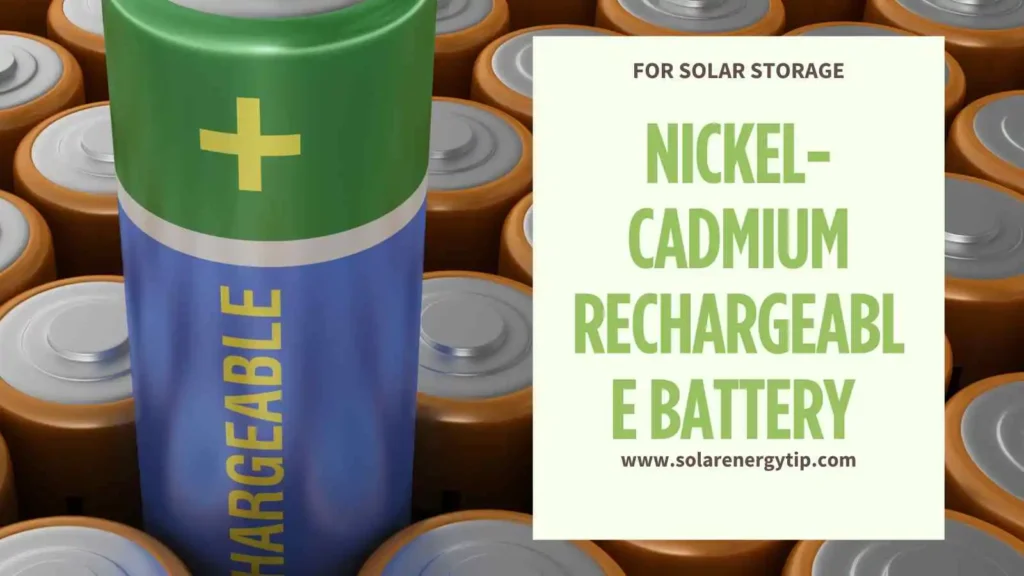
Nickel-based batteries are used in projects to convert large amounts of solar energy into electrical energy, as batteries containing nickel cadmium perform excellently at all temperatures.
Nickel-cadmium batteries have a very long life cycle and do not require any ventilation or cooling.
Nickel-cadmium batteries are available in a very wide range of sizes and performances.
The nickel-cadmium battery is durable and capable of operating even at high temperatures, except the battery management system is simple and maintenance-free.
👉 The most significant minus point of nickel-cadmium batteries is that cadmium is highly toxic. The use of cadmium is banned in some countries of the world, making it very difficult to dispose of cadmium.
Flow Batteries Energy Storage in the Solar System
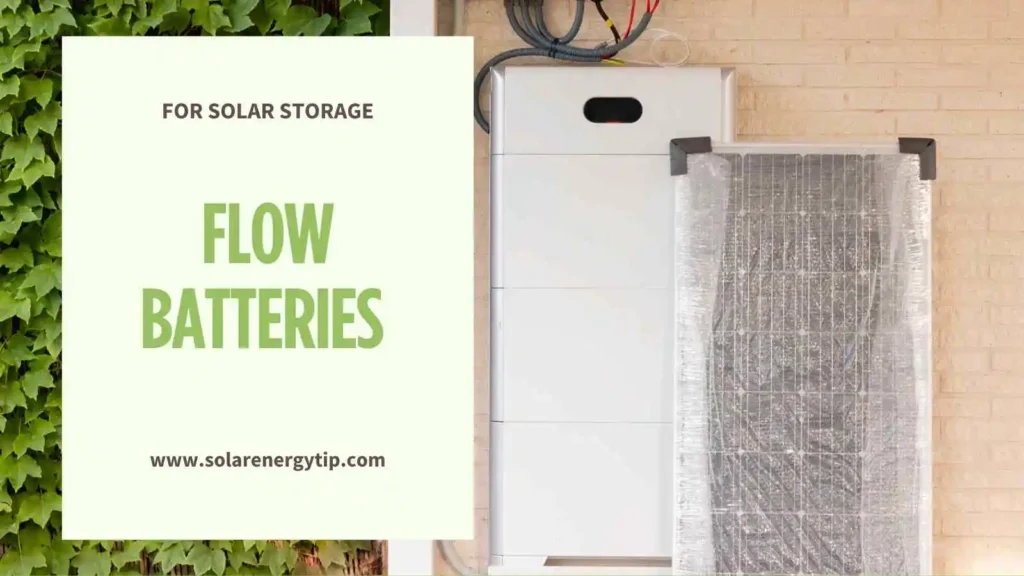
Hey friend, If you wanna use a flow battery to store power from solar, here’s the lowdown: It’s a new, flexible battery that uses flowing liquid electrolytes to store energy.
As the liquid flows, chemical reactions charge the battery. A key benefit is they discharge fully, so they are great for large solar setups.
Redox flow batteries
Redox flow batteries have flexible energy storage technology but are expensive and large.
How to Use a Solar Panel Charges a Battery – Which Uses in Different work
Here is information on how to store generated electrical energy using solar panels in your home, office, business space, or a large-scale solar plant.
How this storage occurs in different types of batteries and in different types of items.
How to Work a Solar Panel to Charge a Battery for a Car
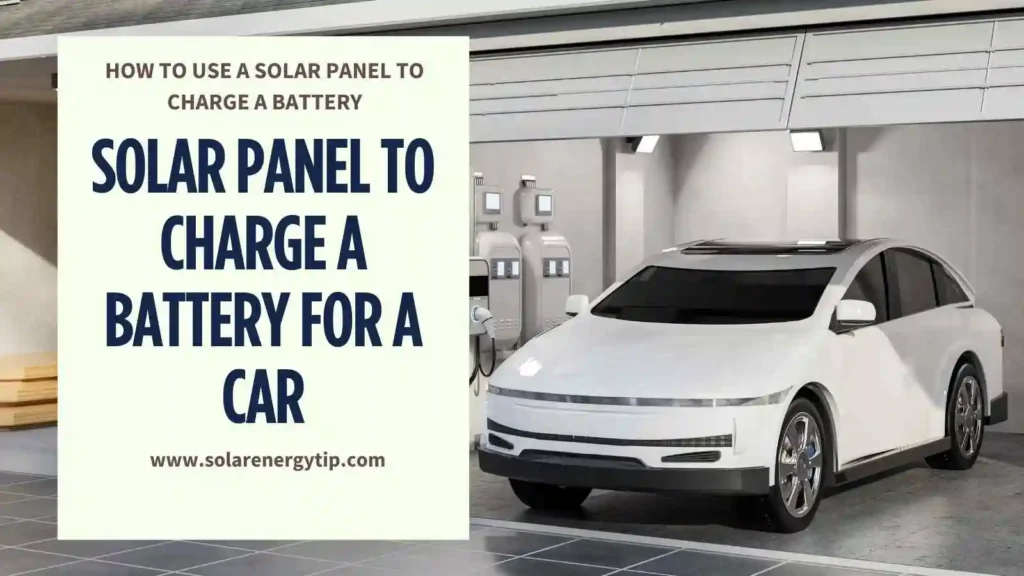
If sometimes your car’s battery is discharged and you have to charge it with a solar panel, you can. For that, you need a solar panel and also a charge controller.
This information I give you means that I have my car, and in a car, I have a solar panel; when my car battery is discharged in an emergency, I often charge the battery with the solar panel.
First, you need a solar panel and a charge controller to charge your car battery according to the battery’s capacity. Then, connect the solar panel to the battery using a charge controller or a voltmeter.
When the voltmeter shows you 14 volts, understand that your battery is charged; disconnect the solar panel to protect your battery from overcharging.
Your battery may be damaged if your charging is too fast, so you will not get a large solar panel for your battery.
How to Connect a Solar Panel to Charge a Battery of 12Volt
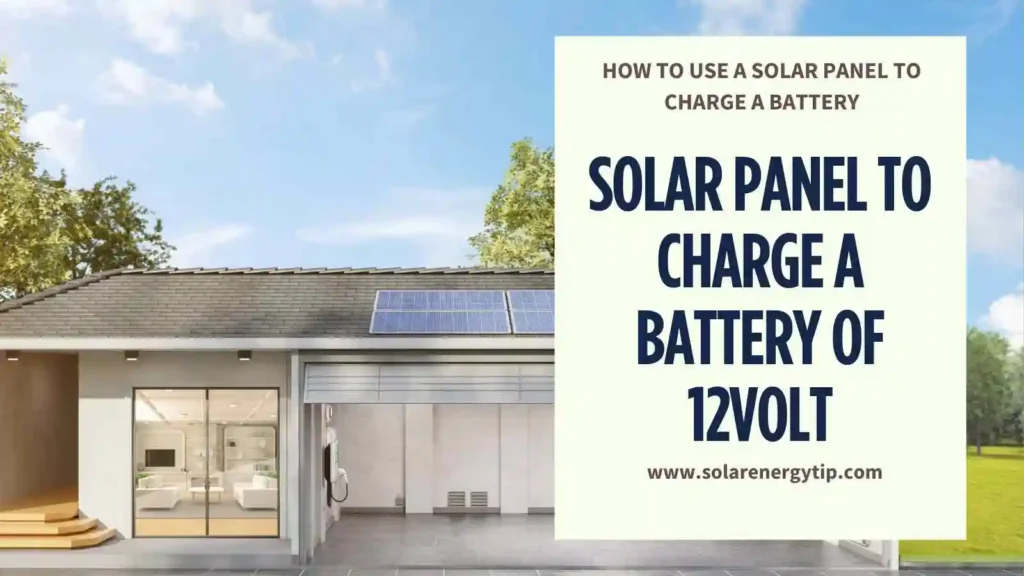
If you have a 12-volt battery, we will see information on connecting a solar panel to a 12-volt battery.
Here are some steps to connect a solar panel to a 12-volt battery.
First of all, you have to find the right place for the solar panel to be installed, and you have to go through the installation process.
You have to arrange all the solar panels in parallel and do the wiring properly.
The solar panel is then connected to the charge controller, which is connected to a 12-volt battery.
If you have a solar panel of 200 watts and want to charge a 12-volt battery, you need 1200 watts÷12 volts= 100 amps, the charge controller in this system.
The charge controller is then connected to a 12-volt battery with appropriate wiring and usually uses a 3, 6, or 9-gauge wire for this connection.
Thus, you get information on how to employ a solar panel to charge a battery of 12 volts.
How to Utilize a Solar Panel to Charge a Battery For a Phone
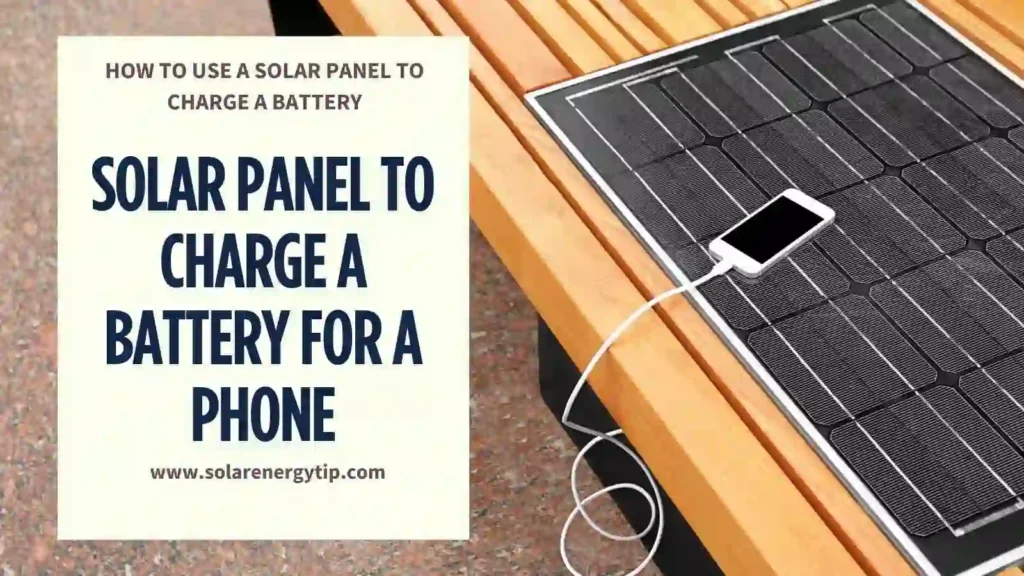
Mobile phones are very important in the life of every person in the world today, So at such times, you may think, can I use a solar panel to charge my phone?
So my answer would be an absolute yes. But there are some things to keep in mind.
If your phone is discharged, you cannot charge it directly to the solar panel and never try to do so, as it may damage the battery of your mobile.
Do you realize,
If you have been traveling or campaigning, you use the power bank to charge your phone if it discharges at that time.
In the meantime, if your power bank is also discharged, you can recharge your power bank with a solar panel using a portable solar panel.
There are many solar panels available in the market that you can use in your camping, through which you can charge your phone or even your laptop.
The batteries are attached to the portable solar panels available in such markets.
FAQs
Can I charge a battery directly from a solar panel?
Yes, you can charge your battery directly with the solar panel, but for that, you have to fit a charge controller between the solar panel and the battery, which shows you the voltage counting. Which controls the power saved in the battery.
What size solar panel to charge 100ah battery?
If you want to charge a 100-ah battery, you have to connect a 300-watt solar panel or you have to look at 3 solar panels 100 watts.
How fast can a solar panel charge a battery?
If the battery is completely drained, solar panels typically charge a battery for five to eight hours. The battery charging time also depends on the weather.
Conclusion
You may have found out how to charge your battery with a solar panel as well as in this article. You may have realized how to use a solar panel to charge a battery.
As well as the six steps for charging a solar battery, the types of solar batteries, the circuit of the solar panel for charging the battery, the components used in the solar panel circuit, and the battery used in different places with the solar panel, and how to charge the battery.
All this information is obtained.

